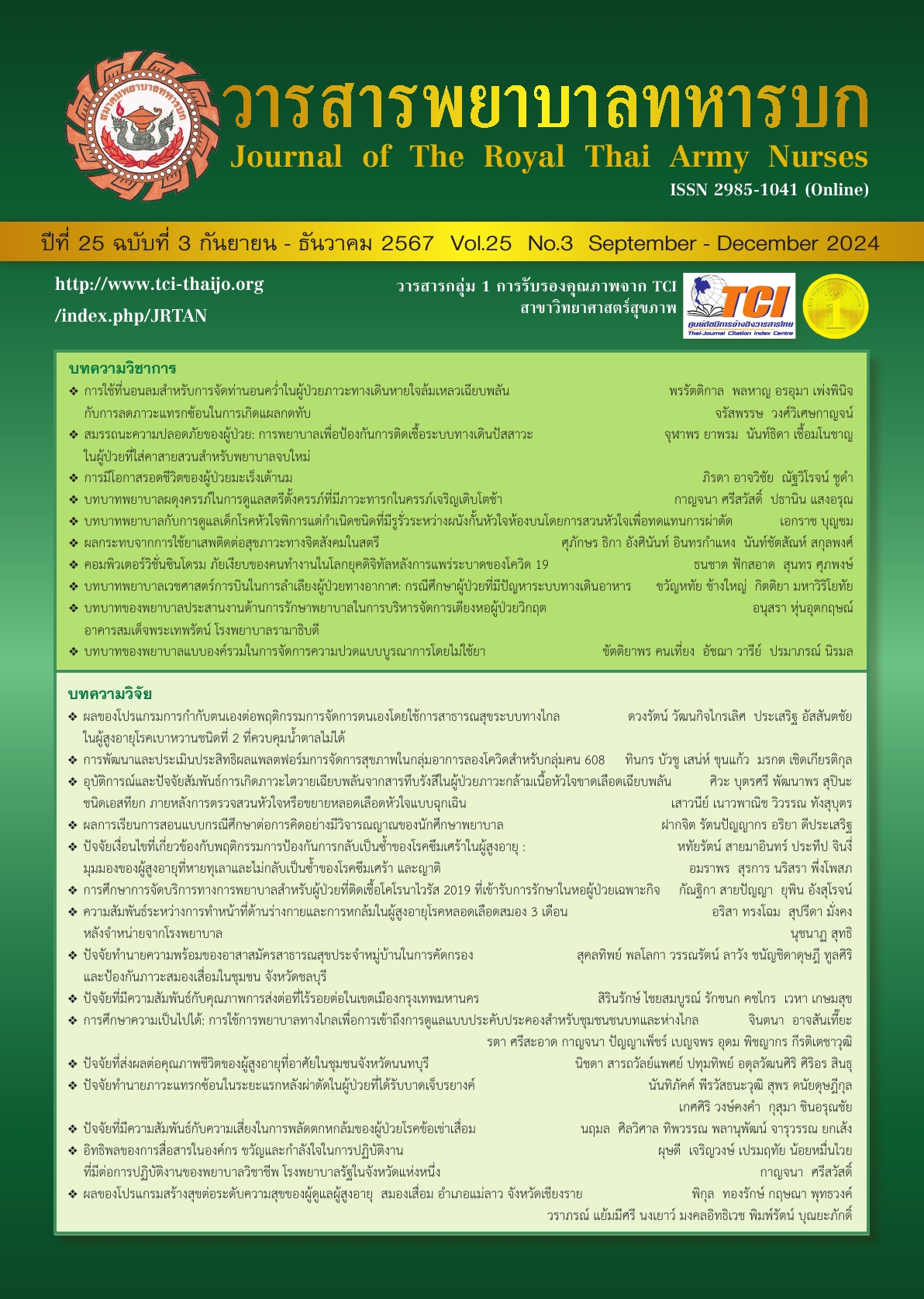Predicting Factors of Early Postoperative Complications in Extremities Injury Patients
Keywords:
The severity of injuries, the period from injury to surgery, body mass index, the surgical frailty, early postoperative complications in patients with extremity injuresAbstract
This research aimed to study the severity of the injury, the period from injury to surgery, body mass index, and the surgical frailty to early postoperative complications in patients with extremity injuries. The sample was patients with extremity injuries and/or injuries of other systems who underwent 146 extremity surgeries. The instruments used for data collection were The Injury Severity Score, The 5-Item Modified Frailty Index, and The Adapted Clavien Dindo in trauma. Statistical analysis using Logistic regression with enter method. The results of the analysis found that the severity of the injury, the period from injury to surgery, and the surgical frailty could predict the early postoperative complications in patients with extremity injuries for 40.5% with statistical significance (Nagelkerke R2 = .405, p< .05). Therefore, this knowledge should be applied to create a guideline for preoperative and postoperative care and prevention of severe complications in patients with extremity injuries. The results of this study are used as information for planning with a multidisciplinary team in caring for patients with extremity injuries who have undergone surgery and preventing possible complications.
Downloads
References
Mahdian M, Fazel RM, Sehat M, Khosravi G, & Mohammadzadeh M. Epidemiological Profile of Extremity Fractures and Dislocations in Road Traffic. Accidents in Kashan, Iran: a Glance at the Related Disabilities. The Archives of bone and joint surgery. 2017; 5(3): 186-92.
World Health Organization. Physical activit. Geneva: WHO; 2020.
Office of Transport and Traffic Policy and planning. Minutes Ministry of Defense Road Accident Situation. Bangkok: OTP; 2020.
Harris AM, Althausen PL, Kellam J, Bosse MJ, & Castillo R. Complications Following LimbThreatening Lower Extremity Trauma. Journal of Orthopaedic Trauma. 2014; 23(1); 1-6.
Mueck KM, & Kao LS. Patients at High-Risk for Surgical Site Infection. Surgical Infections. 2017; 18(4): 440-6.
Rattanamongkol C, Sindhu S, Toskulkao T, & Iramaneerat C. Factors Related to the Severity of Postoperative Complications in Patients with Primary Gastrointestinal (Stomach, Liver, Bile Duct, Colon, and Rectum) Cancer.Thai Journal of Nursing Council. 2016; 31(3): 97-109. (in Thai)
Roy C. The Roy adaptation model. 3rd ed. Upper Saddle River (NJ): Pearson; 2008.
Khorgami Z, Ewing KL, Mushtaq N, Chow GS, & Howard CA. Predictors of discharge destination in patients with major traumatic injury: Analysis of Oklahoma Trauma Registry. The American Journal of Surgery. 2019; 218(3): 496-500.
Riedel MD, Parke A, Zheng M, Briceno J, Staffa SJ, Miller CP, Kaiser PB, Wu JS, Zurakowski D, & Kwon JY. Correlation of Soft Tissue Swelling and Timing to Surgery With Acute Wound Complications for Operatively Treated Ankle and Other Lower Extremity Fractures. Foot & Ankle International. 2019; 40(5): 526–36.
Rege M, Runner RP, Staley CA, Vu CC, Arora SS, & Schenker ML. Predicts mortality and complications in chronologically young patients with traumatic orthopaedic injuries. Elsevier Ltd. 2018; 49: 2234-8.
Omoke NI, & Nwigwe CG. An analysis of risk factors associated with traumatic extremity amputation stump wound infection in a Nigerian setting. International Orthopaedics. 2012; 36(11): 2327-32.
Baker SP, O’neill B, Haddon W, & Long WB. The Injury Severity Score: a method for Describing patients with multiple injuries and evaluating emergency care. Journal Trauma. 1974; 36(11): 2327-32.
Omoke NI, & Nwigwe CG. An analysis of risk factors associated with traumatic extremity amputation stump wound infection in a Nigerian setting. International Orthopaedics. 2012; 36: 2327–32.
Prommapun B. Interpreting Techniques for Using Parametric and Nonparametric Statistics in Social Sciences Research. Electronic Journal of Open and Distance Innovative Learning (e-JODIL). 2020; 10(1): 1-9.
Velanovich V, Antoine H, Swartz A, Peters D, & Rubinfeld I. Accumulating deficits model of frailty and postoperative mortality and morbidity: its application to a national database. Journal of Surgical Research. 2013; 18(3): 104-10.
Naumann DN, Vincent LE, Pearson N, Beaven A, Smith IM, Smith K, et al. An adapted Clavien-Dindo scoring system in trauma as a clinically meaningful non-mortality endpoint. Journal of Trauma and Acute Care Surgery. 2018; 83(2): 241-8.
Pundee J, Chayaput P, Chanruangvanich W, & Wannatoop T. Predictors of Functional Restoration in Extremity Injury Patients. Journal of Thailand Nursing and Midwifery Council. 2019; 34(4): 48-63. (in Thai)
Pincus D, Ravi B, Wasserstein D, Huang A, Paterson M, Nathens BA, et al. Association Between Wait Time and 30-Day Mortality in Adults Undergoing Hip Fracture Surgery. The Journal of the American Medical Association. 2017; 318(20):1994-2003.
Stavem K, Naumann MG, Sigurdsen U, & Utvag SE. The association of body mass Index with complications and functional outcomes after surgery for closed ankle fractures. Bone Joint Journal. 2017; 99(10): 1389-98.
Pramnoi T, Danaidutsadeekul S, & Chanruangvanich w. Factors Predicting Traumatic Patients Readiness for Hospital Discharge after Extremity Surgery. Journal of Royal Thai Army Nurses. 2022; 23(2): 179-87. (in Thai)
Wilson JM, Holzgrefe RE, Staley CA, Schenker, ML, & Meals CG. Use of a 5-Item Modified Frailty Index for Risk Stratification in Patients Undergoing Surgical Management of Distal Radius Fractures. The journal of Hand Surgery. 2018; 40(8): 701-9.
Downloads
Published
How to Cite
Issue
Section
License
Copyright (c) 2024 Journal of The Royal Thai Army Nurses

This work is licensed under a Creative Commons Attribution-NonCommercial-NoDerivatives 4.0 International License.
บทความหรือข้อคิดเห็นใดใดที่ปรากฏในวารสารพยาบาลทหารบกเป็นวรรณกรรมของผู้เขียน ซึ่งบรรณาธิการหรือสมาคมพยาบาลทหารบก ไม่จำเป็นต้องเห็นด้วย
บทความที่ได้รับการตีพิมพ์เป็นลิขสิทธิ์ของวารสารพยาบาลทหารบก
The ideas and opinions expressed in the Journal of The Royal Thai Army Nurses are those of the authors and not necessarily those
of the editor or Royal Thai Army Nurses Association.






